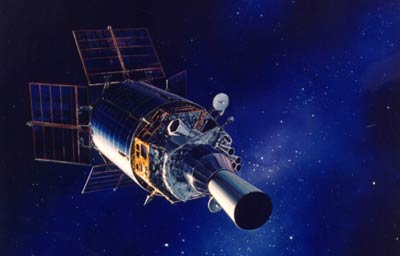Hybrid wars and satellite vulnerabilitiesby Taylor Dinerman
|
| The biggest space targets for terrorists are here on Earth. Ground control stations, industrial sites, and even critical individuals are all possible targets for terrorists who want to disrupt satellite operations. |
As things stand, it is almost impossible to deter this kind of attack, so the only answer is to take protective measures. These include standard security procedures, such as moving antennas to places where they are not easily accessed by outsiders, and making sure that critical personnel understand that they could be targeted and that they know how to recognize the signs. Protecting these assets may not be easy, but it is no more difficult than protecting any other high value target, such as a nuclear power plant or a military base.
Satellites in orbit are far more difficult to attack or to defend. In low Earth orbit (LEO) they can be attacked using pseudo-debris (co-orbiting anti-satellite weapons disguised as debris) or direct ascent weapons. These last are probably going to proliferate within the next few years. Russia has developed a small satellite launcher that uses a MiG-31 as its first stage. Israel tests its Arrow missile defense system using a Black Sparrow rocket-powered target launched from an F-15. In both cases, it might be possible to modify the rockets into an anti-satellite weapon comparable to the US one that was successfully tested in the mid-1980s.
For example, the MiG-31 is derived from the MiG-25, which has long been used by the air forces of nations such as Algeria, Libya, and Syria, and is probably available on the world arms market at affordable prices. Modifying one to allow it to launch anti-satellite weapons may not be a piece of cake, but neither is it beyond the ability of a minimally sophisticated air force. It would be hard, but not impossible, to use the suborbital rocket planes being built to carry tourists to launch these kinds of anti-satellite weapons.
Direct ascent weapons could be ideal weapons for those who wish to destroy orbiting targets while preserving their anonymity or, at least, their “plausible deniability.” A MiG-25 carrying an anti-satellite rocket would not have to take off from, say, an air base in Syria or Iran in order to attack a target in LEO. Instead, it could be based in an impoverished African country or even in a central Asian nation. They could bribe a local leader to allow this without any involvement by the nation’s government. If the US were to lose a satellite over Chad or the Congo, how would it be able to blame a rogue state such as Iran? Even if there were strong indications that it was a particular state, world politics today make it extremely difficult to convince people of this reality. The deniability of such attacks and the fact that they can create more political problems for the victim than the attacker make them particularly attractive.
Satellites in geosynchronous orbit (GEO) are far more difficult to hit than those in LEO. However, if enough of them can be hit at once, the effect of the attack on the world economy could be pretty serious. While communications satellites no longer carry a disproportionate share of global communications, the loss of a dozen or so large commercial communications satellites would cause years of disruption and would drive insurance rates up to “astronomical” levels.
| A supposedly scientific mission to the Moon might be launched that would the “go wrong” and, after a certain interval, the spacecraft might be reactivated and disburse multiple kill vehicles at its targets in GEO. |
The impact of a successful attack on military assets in GEO would be even worse. Losing the high-capacity Milstar and other specialized communications satellites would cripple any number of US military operations. If the DSP missile launch detection satellites or their successors were destroyed, the ability of US and allied forces to defend against ballistic missiles and some types of cruise missiles would be gone. An open attack by a rogue state against these spacecraft would invite a devastating response, so they would need to carry out a disguised attack.
One way to do this might be to launch a pseudo-probe. A supposedly scientific mission to the Moon might be launched that would the “go wrong” and, after a certain interval, the spacecraft might be reactivated and disburse multiple kill vehicles at its targets in GEO. A variant of this would be for the probe to go into orbit around the Moon, or one of the Lagrange points, before carrying out its strike mission. Detecting such a weapon that far from Earth would be extremely difficult. Radar would be almost useless, and Earth-based telescopes would have to ceaselessly monitor such a craft. Planned space-based space surveillance systems are optimized for the observation of LEO and GEO and not for deep space.
The best tool for keeping an eye on such weapons is probably the proposed system for observing and tracking Earth-crossing objects, sometimes referred to as the “doomsday asteroids.” As the real potential for space warfare becomes more and more evident, the need for comprehensive and effective surveillance of cislunar space becomes, in turn, inescapable.
